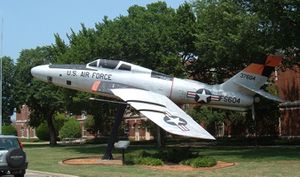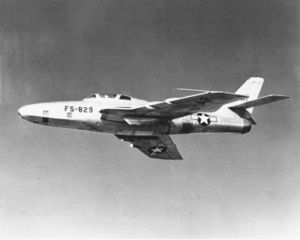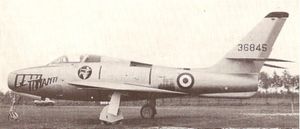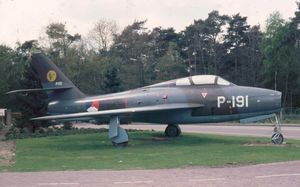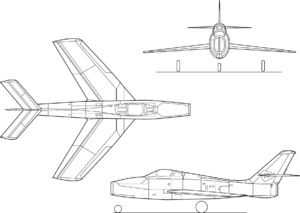PlaneSpottingWorld welcomes all new members! Please gives your ideas at the Terminal.
F-84F Thunderstreak
| F-84F Thunderstreak RF-84F Thunderflash | |
|---|---|
| USAF F-84F Thunderstreak | |
| Type | Fighter-bomber |
| Manufacturer | Republic Aviation Company |
| Designed by | Alexander Kartveli |
| Retired | 1972 US ANG 1991 Greece |
| Primary user | United States Air Force |
| Unit cost | US$769,330 (F-84F) |
| Developed from | F-84 Thunderjet |
| Variants | XF-84H Thunderscreech |
The Republic Aviation Company F-84 Thunderjet was an American-built turbojet fighter-bomber aircraft. Originating as a 1944 United States Air Force proposal for a daytime fighter, the F-84 flew in 1946. Although it entered service in 1947, the Thunderjet was plagued by so many structural and engine problems that a 1948 Air Force review declared it unable to execute any aspect of its intended mission and considered cancelling the program. The aircraft was not considered fully operational until the 1949 F-84D model and the design matured only with the definitive F-84G introduced in 1951. In 1954, the straight-wing Thunderjet was joined by the swept-wing F-84F Thunderstreak fighter and RF-84F Thunderflash photo reconnaissance aircraft.
The USAF Strategic Air Command had F-84 Thunderjets (F-84s and RF-84s) in service from 1948 through 1957.
The Thunderjet became the Air Force's primary strike aircraft during the Korean War, flying 86,408 missions and destroying 60% of all ground targets in the war as well as eight Soviet-built MiG fighters. Over half of the 7,524 F-84s produced served with NATO nations, and it was the first aircraft to fly with the U.S. Air Force Thunderbirds demonstration team.
The F-84 was the first production fighter aircraft to utilize in-flight refueling and the first fighter capable of carrying a nuclear bomb. Modified F-84s were used in several unusual projects, including the FICON and Tom-Tom dockings to the B-29 and B-36 bomber motherships, and the experimental XF-84H Thunderscreech supersonic turboprop.
Contents
Design and development
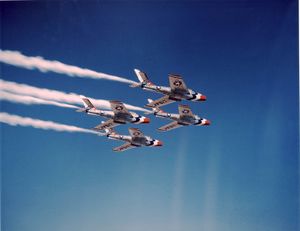
In 1949, Republic created a swept wing version of the F-84 hoping to bring performance to the F-86 level. The last production F-84E was fitted with a swept tail, a new wing with 38.5 degrees of leading edge sweep and 3.5 degrees of anhedral, and a J35-A-25 engine producing 5,300 pound-force (23.58 kN) of thrust.[1] The aircraft, designated XF-96A flew on 3 June 1950 with Otto P. Haas at the controls. Although the airplane was capable of 602 knots (693 mph, 1,115 km/h), the performance gain over the F-84E was considered minor.[1] Nonetheless, it was ordered into production in July 1950 as the F-84F Thunderstreak. The F-84 designation was retained because the fighter was expected to be a low-cost improvement of the straight-wing Thunderjet with over 55 percent commonality in tooling.[1] In the meantime, USAF arranged for the British Armstrong Siddeley Sapphire turbojet to be built in the United States as the Wright J65 in the hopes that the more powerful engine would improve high-altitude performance. To accommodate the larger engine, YF-84F with a British-built Sapphire as well as production F-84Fs with J65 had a vertically stretched fuselage with the air intake attaining an oval cross-section. Production delays with the F-84F forced USAF to order a number of straight-wing F-84Gs as an interim measure.[1]
Production quickly ran into problems. Although tooling commonality with the Thunderjet was supposed to be 55 percent, in reality only 15 percent of tools could be reused.[1] To make matters worse, the F-84F utilized press-forged wing spars and ribs. At the time, only three presses in United States could manufacture these and the priority was given to the B-47 Stratojet bomber.[1] The YJ65-W-1 engine was considered obsolete and the improved J65-W-3 did not become available until 1954. When the first production F-84F finally flew on 22 November 1952, it differed from the service test aircraft in having a different canopy which opened up and back instead of the sliding to the rear as well as airbrakes on the sides of the fuselage instead of the bottom of the aircraft.[1] The aircraft was considered not ready for operational deployment due to control and stability problems. Since early aircraft suffered from accelerated stall pitch-up, F-84F-25-RE introduced an all-moving tailplane. A number of aircraft were also retrofitted with spoilers for improved high-speed control. As the result, the F-84F was not declared operational until 12 May 1954.[1]
Operational history
Project Run In operational tests completed in November 1954 finally found the aircraft to be to USAF satisfaction and considerably better than the F-84G. However, ongoing engine failures resulted in the entire fleet being grounded in early 1955. Furthermore, the J65 continued to suffer from flameouts when flying through heavy rain or snow.[1] As the result of the delays, the active duty phaseout began almost as soon as the F-84F entered service in 1954, and was completed by 1958. Increased tensions in Germany associated with construction of the Berlin Wall in 1961 resulted in reactivation of the F-84F fleet. In 1962, the fleet was grounded due to corrosion of control rods and a total of 1,800 man hours was expended to bring each aircraft to full operational capacity.[1] The aircraft were finally retired in 1964. Stress corrosion forced retirement of ANG F-84Fs in 1971.
The second YF-84F prototype was completed with wing-root air intakes which were not adopted for the fighter due to loss of thrust. However, this arrangement permitted placement of cameras in the nose and the design was adopted for the RF-84F Thunderflash reconnaissance version. The first YRF-84F was completed in February 1952.[1] The aircraft retained an armament of four machine guns and could carry up to fifteen cameras. Innovations included computerized controls which adjusted camera settings for light, speed, and altitude, a periscope to give the pilot better visualization of the target, and a voice recorder to let the pilot narrate his observations. Being largely identical to the F-84F, the Thunderflash suffered from the same production delays and engine problems, delaying operational service until March 1954. The aircraft was retired from active duty in 1957, only to be reactivated in 1961, and finally retired from ANG in 1972.[1]
Several modified Thunderflashes were used in the FICON project.
Flying the Thunderstreak
The Thunderstreak suffered from the same poor takeoff performance as the straight-wing Thunderjets in spite of having a more powerful engine. In reality, almost 700 pound-force (3.11 kN) or 10 percent of total thrust was lost because the J65 was installed at an angle and its exhaust had a prominent kink. On a hot day, 7,500 feet (2,285 m) of runway were required for takeoff roll.[2] A typical takeoff speed was 160 knots (185 mph, 300 km/h).[2] Like the Thunderjet, the Thunderstreak excelled at cruise and had predictable handling characteristics within its performance envelope. Like its predecessor, it also suffered from accelerated stall pitch-up and potential resulting separation of wings from the airplane. In addition, spins in the F-84F were practically unrecoverable and ejection was the only recourse below 10,000 feet (3,000 m).[2]
With the appearance of the F-105 Thunderchief, the Thunderstreak became known as the Thud's Mother.[2]
Notable achievements[1]
By the mid-1960s, the F-84F was replaced by the F-100 Super Sabre and the RF-84F by the RF-101 Voodoo in USAF units, being relegated to duty in the Air National Guard. The last F-84F Thunderflash retired from the ANG in 1971. Three Hellenic Air Force RF-84Fs that were retired in 1991 were the last operational F-84s.
Costs
The costs are in approximately 1950 United States dollars and have not been adjusted for inflation.[1]
| F-84B | F-84C | F-84D | F-84E | F-84G | F-84F | RF-84F | |
|---|---|---|---|---|---|---|---|
| Airframe | 139,863 | 139,863 | 150,846 | 562,715 | 482,821 | ||
| Engine | 41,654 | 41,654 | 41,488 | 146,027 | 95,320 | ||
| Electronics | 7,165 | 7,165 | 4,761 | 9,623 | 21,576 | ||
| Armament | 23,559 | 23,559 | 37,433 | 41,713 | 63,632 | ||
| Ordnance | 2,719 | 9,252 | 4,529 | ||||
| Flyaway cost | 286,407 for the first 100 163,994 for the next 141 |
147,699 | 212,241 | 212,241 | 237,247 | 769,300 | 667,608 |
| Cost per flying hour | 390 | ||||||
| Maintenance cost per flying hour | 185 | 185 |
Variants
- YF-84F
- Two swept-wing prototypes of the F-84F.
- F-84F Thunderstreak
- Swept wing version initially designated F-96. Wright J65 engine, Tactical Air Command aircraft were equipped with Low-Altitude Bombing System (LABS) for delivering nuclear bombs. 2,711 built, 1,301 went to NATO under Mutual Defense Assistance Program (MDAP).
- GRF-84F
- 25 RF-84Fs were converted to be carried, and launched from the bomb-bay of a GRB-36F bomber as part of the FICON project. The aircraft were later redesignated RF-84K.
- RF-84F Thunderflash
- Reconnaissance version of the F-84F, 715 built.
- XF-84H
- Two F-84Fs were converted into experimental aircraft. Each was fitted with a Allison XT40-A-1 turboprop engine of 5,850 shaft horsepower (4,365 kW) driving a supersonic propeller. Ground crews dubbed the XF-84H, the Thunderscreech due to its extreme noise level.[1]
- YF-84J
- Two F-84Fs were converted into YF-84J prototypes with enlarged nose intakes and a deepened fuselages for the General Electric J73 engine; the YF-84J reached Mach 1.09 in level flight on 7 April 1954.[1] The project was cancelled due to the excessive cost of conversion of existing F-84Fs.
Operators
- Belgium
- France
- Denmark
- Germany
- Greece
- Iran
- Italy
- Netherlands
- Norway
- Portugal
- Republic of China
- Thailand
- Turkey
- United States
- Yugoslavia
Specifications (F-84F)
Data from Fighters of the United States Air Force[3]
General characteristics
- Crew: 1
- Length: 43 ft 4¾ in (13.23 m)
- Wingspan: 33 ft 7¼ in (10.25 m)
- Height: 14 ft 4¾ in (4.39 m)
- Wing area: 325 ft² (30 m²)
- Empty weight: 13,830lb (5,200 kg)
- Loaded weight: lb (kg)
- Max takeoff weight: 28,000 lb (12,701 kg)
- Powerplant: 1× Wright J-65-W-3 turbojet, 7,220 lbf (32.2 kN)
Performance
- Maximum speed: 695 mph (604 knots, 1,119 km/h) at sea level
- Range: 810 mi (704 nm, 1,304 km) combat radius with two droptanks
- Service ceiling: 46,000 ft (14,000 m)
- Rate of climb: 8,200 ft/min (42 m/s)
- Wing loading: 86 lb/ft² (423 kg/m²)
Armament
- 6× .50 in (12.7 mm) Browning M3 machine guns,
- Up to 6,000lb (2,727 kg) of rockets and bombs, including one Mark 7 nuclear bomb
Avionics
- A-1CM or A-4 gunsight with APG-30 or MK-18 ranging radar
References
- ↑ 1.00 1.01 1.02 1.03 1.04 1.05 1.06 1.07 1.08 1.09 1.10 1.11 1.12 1.13 1.14 1.15 Knaack, Marcelle Size. Encyclopedia of US Air Force Aircraft and Missile Systems: Volume 1 Post-World War II Fighters 1945-1973. Washington, DC: Office of Air Force History, 1978. ISBN 0-912799-59-5.
- ↑ 2.0 2.1 2.2 2.3 Higham, R. and Williams, C. Flying Combat Aircraft of USAAF-USAF (Vol.2). Rockville, Maryland: Air Force Historical Foundation, 1978. ISBN 0-8138-0375-6.
- ↑ Dorr, Robert F. and Donald, David. Fighters of the United States Air Force. London: Temple Press Aerospace, 1990. ISBN 0-600-55094-X.
- Bowers, Peter M. and Angellucci, Enzo. The American Fighter. New York: Orion Books, 1987. ISBN 0-517-56588-9.
- Donald, David and Lake, Jon, eds. Encyclopedia of World Military Aircraft. London: AIRtime Publishing, 1996. ISBN 1-880588-24-2.
- Forrer, Frits T.The Fun of Flying. Gulf Breeze, Florida: Holland's Glory, 1992. ISBN 0-9714490-3-1.
- Keaveney, Kevin. Republic F-84/Swept-Wing Variants (Aerofax Minigraph, No 15). London: Aerofax, 1987. ISBN 0-942548-20-5.
- Swanborough, Gordon and Bowers, Peter M. United States Military Aircraft Since 1909. Washington, DC: Smithsonian, 1989. ISBN 0-87474-880-1.
- Wagner, Ray. American Combat Planes, Third Enlarged Edition. New York: Doubleday, 1982. ISBN 0-385-13120-8.
External links
Related content
Related development
Comparable aircraft
Designation sequence
Lists relating to aviation | |
|---|---|
| General | Timeline of aviation · Aircraft · Aircraft manufacturers · Aircraft engines · Aircraft engine manufacturers · Airports · Airlines |
| Military | Air forces · Aircraft weapons · Missiles · Unmanned aerial vehicles (UAVs) · Experimental aircraft |
| Notable incidents and accidents | Military aviation · Airliners · General aviation · Famous aviation-related deaths |
| Records | Flight airspeed record · Flight distance record · Flight altitude record · Flight endurance record · Most produced aircraft |
de:Republic F-84 fa:اف-۸۴ تاندرجت fr:F-84 Thunderjet it:Republic F-84 nl:Republic F-84 Thunderstreak ja:F-84 (戦闘機) no:Republic F-84 Thunderjet pl:Republic F-84 Thunderjet pt:F-84 Thunderjet fi:F-84 Thunderjet
